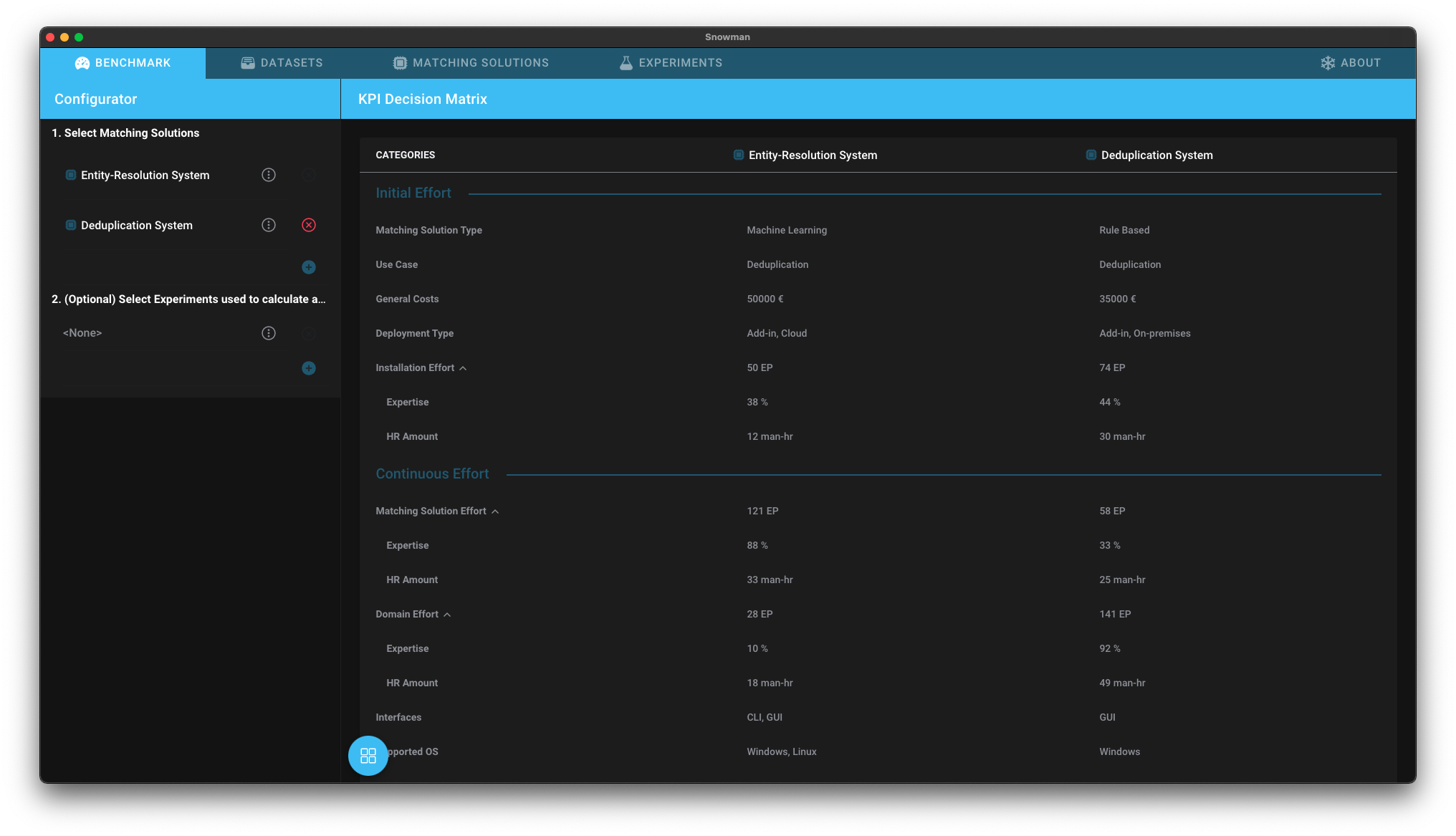KPI Decision Matrix
The KPI Decision Matrix provides you with the most important kpis to make an informed buying decision.

Getting Started
- Add all matching solutions you want to compare to Snowman
- If you have experiments of the matching solution for datasets with a gold standard add them to Snowman
- Open the Benchmark Dashboard and select the analysis KPI Decision Matrix.
- Select your matching solutions and experiments in the configurator
Interpreting the Results
| KPI | Definition |
|---|---|
| Matching Solution Type | The architectural type of the matching solution, such as "Machine Learning", "rule-based" or "Active Learning" |
| Use Case | Which use cases does the matching solution cover (e.g., merging from two file, deduplicating one file, ...)? Some matching solutions do not support every use case. |
| General Costs | These include the cost to buy a matchingsolution, the cost to host the infrastructure, etc.. Since thesecan vary from payment model to payment model (one-timecosts, monthly costs, pay-per-use), they are aggregated overthe entire product lifecycle to increase comparability. Sincethese can vary from payment model to payment model (one-time costs, monthly costs, pay-per-use), they are aggregatedover the entire product lifecycle to increase comparability. |
| Deployment Type | This describes in which way the matching solution has to be deployed: Does a hosted instance exist already? Or is it just locally executable? Hosted instances,for example, often require less maintenance and might be therefore a decision criteria. |
| Installation Effort | Embedding a matching solution in the software landscape of a company requires a specific knowledge level and amount of time which varies for each matching solution. The integration effort is split into these kpis. |
| Matching Solution Effort | Another task is configuring the matching solution itself. Some matching solutions do not require any specific knowledge (for example, solutions where uploading only a file is sufficient), but other matching solution need detailed configurations. Because of that, we propose to measure the effort to configure a matching solution by knowledge-level and HR-Amount. |
| Domain Effort | Matching solutions often require domain knowledge during the configuration phase: A machine learning based approach, for example, needs pre-labeled data to fit the model. For that, a person who knows the domain has to classify given pairs of records, in order to create a trainings dataset. For rule-based approaches domain knowledge is needed, too: Rules have to be created, based on pair-wise similarities. To define effective rules, it requires domain knowledge. This results in a domain effort for the specific matching solution, measured by the required expertise and HR-Amount. |
| Interfaces | This describes the provided interfaces to access the matching solution (e.g.: GUI, API, CLI). Depending on the use case it might be necessary that the matching solution provides a specific interface: For example, the automation of specific data matching tasks requires an API or CLI. |
| Supported OS | On which operating systems is it possible to execute the data matching solution? |
Info
knowledge-level and hr-Amount are mutually dependent. A person with a higher knowledge-level does usually need less time to configure a specific matching solution. To reflect this issue, we provide an aggregated measure. This is calculated with the manhattan-distance between the knowledge-level and the hr-Amount